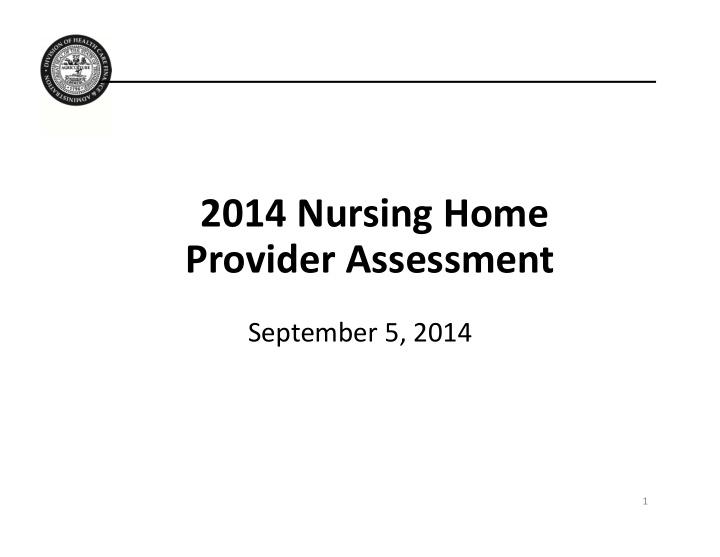



2014 Nursing Home Provider Assessment September 5, 2014 1
Agenda • Overview • How It Works: Assessment • How It Works: Payment • Questions 2
Our Webinar • Joint presentation of THCA and TennCare • Phones are muted • Type questions in box to the side of the webinar window 3
Resources www.tenncaretopics.com • Webinar presentation • Webinar recording • Other reference material • FAQs 4
Overview 5
What We Used to Have • Bed tax • $2,225 per bed • Paid monthly to Department of Health 6
Why the Need to Change • Bed tax not increased since 1992 – Generated $265 million of the $400 million nursing home Medicaid budget (66%) – 95% occupancy and 71% Medicaid patient population • FY 2013 ‐ 14 – Generated less than $240 million of the $880 million in nursing home Medicaid expenditures (27%) – 79% occupancy and 61% Medicaid patient population 7
Why the Need to Change • Continued decline in Medicaid patient days is making the pass ‐ through inefficient – 48% of the tax passed back • Declining overall occupancy has created a surplus of beds for many facilities – penalties • Facilities dropping beds would create long term issues for the bed tax 8
Why the Need to Change • Previous bed tax was no longer an effective source of funding and a long ‐ term solution was needed for TennCare and nursing homes • Contemporary approach – Percentage of industry revenue – 17 other states – Sustainable – Permits growth over time as revenues increase – CMS Approved – uniform and less than 6% 9
Our New Approach • Change the format to 4.5% of industry revenues • Assessed on number of non ‐ Medicare bed days • Paid quarterly to TennCare 10
Our New Approach • More elastic than a flat bed tax and permits some potential growth over time • Much higher pass ‐ through– 60 percent of the assessment paid • Provides additional funds for the transition to a new acuity based Medicaid system on July 1, 2015 11
How It Works: Assessment 12
How It Works: Assessment Data taken from most recent cost reports (2013) and used to set rate • Non ‐ Medicare Patient Days (incl. MA) • Net Patient Revenues • Used to establish Assessment per diem 13
How It Works: Assessment • 2013 Industry Revenues: $2.55 billion • Assessment of 4.5%: $114.4 million • Non ‐ Medicare Patient Days: 9.04 million • Assessment Per Diem: $12.66 14
How It Works: Assessment • Assessment will be due quarterly in four equal payments • Invoices will be sent out in September for first payment • First payment due to TennCare by Oct. 20 • Penalties for delinquent payment are spelled out in legislation 15
How It Works: Assessment • Facilities will be mailed invoices • Payment will be by check, payable to Bureau of TennCare • Include coupon with check when mailing 16
How It Works: Assessment Calculating the Medicaid Pass ‐ Through • Assessment of 4.5%: $114.4 million • Total Patient Days: 11.1 million • Pass ‐ Through Per Diem: $10.30 17
How It Works: Payment 18
How It Works: Payment • Fiscal Year 2014 ‐ 2015 is a transition year • Supplemental payments – 19% to restore 1% rate cut in SFY2015 budget – 1% for systems development (online cost reports) – 30% acuity – method “A” – 30% acuity – method “B” – 20% quality 19
How It Works: Payment Acuity – Method “A” • Identical to the method used to pay out $23.6 million in SFY2013 • Uses Case Mix Index (CMI) scores to establish acuity • Direct care costs, Patient Days 20
How It Works: Payment Acuity – Method “B” • Allocated using only Medicaid CMI scores and patient days 21
How It Works: Payment Acuity Methods “A” and “B” • Direct care costs and patient days from 2013 cost reports • CMIs will be a rolling four quarter average – Ex. Oct 2014 payment will use CMIs from July 2013 ‐ June 2014 • Payment amounts will change quarterly • Payments will be made by MCOs 22
How It Works: Payment Quality • Points awarded according to measures developed with stakeholders • Scores will be updated quarterly • Payment amounts will change quarterly • Payments will be made by MCOs 23
Questions If you have questions please type them into the box to the side of your webinar window 24
Recommend
More recommend